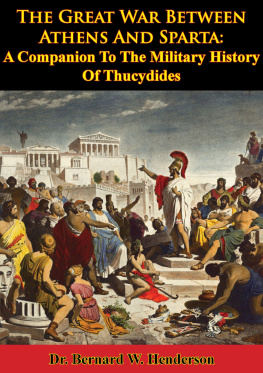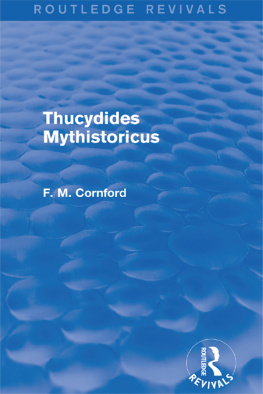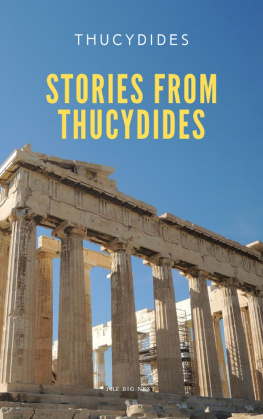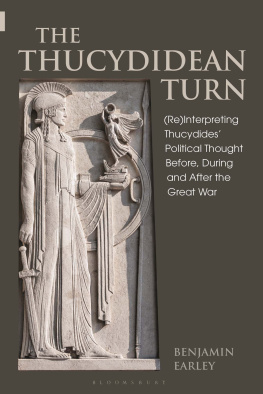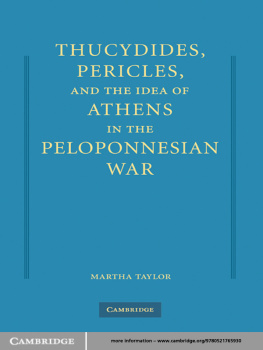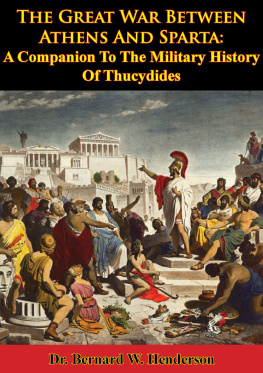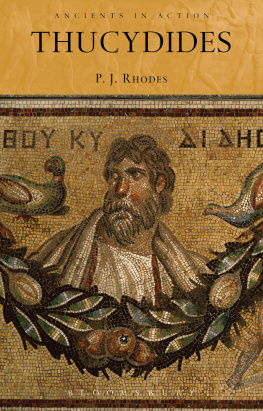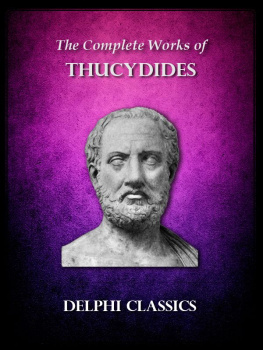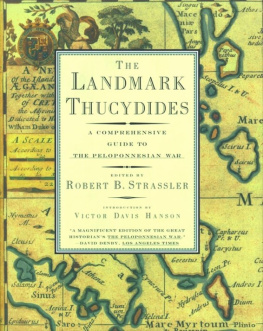

This edition is published by PICKLE PARTNERS PUBLISHINGwww.picklepartnerspublishing.com
To join our mailing list for new titles or for issues with our books picklepublishing@gmail.com
Or on Facebook
Text originally published in 1927 under the same title.
Pickle Partners Publishing 2015, all rights reserved. No part of this publication may be reproduced, stored in a retrieval system or transmitted by any means, electrical, mechanical or otherwise without the written permission of the copyright holder.
Publishers Note
Although in most cases we have retained the Authors original spelling and grammar to authentically reproduce the work of the Author and the original intent of such material, some additional notes and clarifications have been added for the modern readers benefit.
We have also made every effort to include all maps and illustrations of the original edition the limitations of formatting do not allow of including larger maps, we will upload as many of these maps as possible.
THE GREAT WAR BETWEEN ATHENS AND SPARTA
A COMPANION TO THE MILITARY HISTORY OF THUCYDIDES
BY
BERNARD W. HENDERSON
M.A., D.LITT.
(FELLOW AND TUTOR OF EXETER COLLEGE, OXFORD)
AUTHOR OF
CIVIL WAR AND REBELLION IN THE ROMAN EMPIRE
(A COMPANION TO THE HISTORIES OF TACITUS)
ETC., ETC.
TABLE OF CONTENTS
Contents
DEDICATION
TO
J. A. R. MUNRO
NOW RECTOR OF LINCOLN AND SOMETIME SCHOLAR OF EXETER
HIS FORMER TUTOR IN GREEK HISTORY
THIS BOOK
IN TRIBUTE BY A PUPIL
NOW FELLOW OF EXETER AND SOMETIME SCHOLAR OF LINCOLN
PREFACE
THIS book is intended primarily to help students of Thucydides, whether in Greek or in English, at schools and universities. At Oxford in particular there are many undergraduates in these days whose business it is to read three books of Thucydides in Jowetts translation There is therefore not one word in Greek script in the whole of this book, and, apart from the proper names, there are only two or three Greek terms transliterated into English. But, at my publishers wise insistence, I have given all references to my Greek authors and have also carried on the subject down to the end of the war after Thucydides narrative ends. I hope the book may thus be of special use besides to students of Literae Humaniores, and it is a course of lectures for this School (frequently revised) which is its foundation. It is on behalf of these students that I have called attention in occasional notes to certain notable controversies, the evidence for them, and their protagonists. Possibly too, other students of military history, whether ancient or modern, may find matter to interest them in this book. Through-out it I have made all such use of Aristophanes as I could. Even for what is a military history, that of the Peloponnesian War, the poet as a source of evidence is invaluable. A special index of the passages in Aristophanes used in this book is added.
My colleagues, Mr. E. A. Barber and Mr. H. R. Raikes, have kindly given me some help in the reading of the proofs. My very special thanks also are due to my colleague Mr. C. T. Atkinson, who has read the whole book through in proof. His expert and unrivalled knowledge of military and naval history has not only continually assisted me with comment and criticism, but also it has enriched this book with additional examples of great interest.
BERNARD W. HENDERSON.
EXETER COLLEGE,
OXFORD,
July 17, 1926.
MAPS AND PLANS
CHAPTER II.Map: Boeotia and Attica
Plan: The salient of Plataea
CHAPTER III.Map: The entrance to the Corinthian Gulf
CHAPTER IV.Map: The North-West
Map: The Isthmus of Corinth and Salamis
Map: AetoliaPhocisBoeotia
Map: Aetolia
Plan: Aegitium
Map: The eastern shore of the Ambraciot Gulf
Plan: The battle of Olpae
Plan: Poplar Grove
CHAPTER V.Map: Pylos and Sphacteria
CHAPTER VI.Plan: The battle of Delium
Plan: Megara and Nisaea
VII.Map: Macedonia-Chalcidice
Plan: Amphipolis
CHAPTER VIII.Map: The Eastern Peloponnese
Map: PhliusNemeaArgos
Plan: The armies at Argos (intended)
Plan: The armies at Argos (actual)
Map: Mantinea and Tegea
Plan: The battle of Mantinea
CHAPTER IX.Map: Sicily
Plan: The battle of Dascon
Plan: Syracuse.
Map: The route of the Athenian retreat.
CHAPTER X.Map: The coast of Asia Minor
Map: The Hellespont
CHAPTER XI.Plan: The battle of Arginusae
CHAPTER ITHE CAUSE OF THE WAR
1. Sparta
SPARTA was bitterly jealous of Athens, and with reason.
Fifty years ago the two had fought gloriously side by side to drive the Persian invader away in rout from Greece. In that war for freedom Spartas had been the leadership by land and by sea. The glory of the victory was shared between them. Their friendship had seemed built now for ever on the rock of a common peril faced, a common triumph won.
In the fifty years which followed the last great victories of Salamis, Plataea, and Mycale, Athens had become mistress of a maritime empire. She ruled a thousand cities, boasted her poet. A still greater affront to Corinth was his alliance with her erstwhile colony and bitter foe Corcyra.
Corcyra was necessary to Athens. In days before the invention of the mariners compass ships dared not strike boldly across the open sea Westward Ho! from the shelter of the Corinthian Gulf. The shortest sea passage was the safest, and traders for Italy and Sicily crept up the coast northwards to Corcyra before venturing across to Italy. Just before the outbreak of the great war the constant bickering between Corcyra and Corinth had flamed out into open war, the pretext, the affairs of a miserable little city Epidamnus on the western coast; the cause, the long-standing feud and commercial rivalry between the two powerful cities. Pericles concluded an alliance with Corcyra. Spartas proudest tradition was that of liberator of Hellas. She could not refuse the rle.
For Corinths vigorous appeal was reinforced by two other most unhappy Greek cities.
Megara, on the isthmus of Corinth, was a city of ancient renown. But since the Persian wars she had fallen upon evil days. Her ill luck it was to be equally important to both of the two rival powers in Greece. In alliance with Athens, she safeguarded the latter from all peril of invasion by land from the south. In alliance with Sparta, she opened the highway to the most powerful army in the land to march undisturbed into Attica and there join hands with the Boeotians, Athens northern enemies, who, by themselves, dared not do more than make forays over the frontier, if they ventured even this. The strategical importance of Megara to both sides it is impossible to exaggerate. It was the friendship of Megara with Sparta that determined the plans of campaign of both sides at the outset of the great war.
If useful to Sparta, Megara was vital to Athens. She had two ports, Nisaea on the Saronic Gulf, almost in sight of Athens, Pagae on the Corinthian Gulf. Continuous walls linked Nisaea with Megara, as Peiraeus with Athens. No Peloponnesian army could mask the linked-fortress and brave the narrow passage of the Scironian Way between mountain and sea if Megara lay starkly hostile, threatening its communications with its base in the Peloponnese. Thirty years earlier the Athenians had won over Megara to their friendship. At that time Athens had been mistress of Achaea, the strip of coast land on the south of the Corinthian Gulf, of Naupactus, a lonely fort at the western entrance of that Gulf, and, using Pagae, her ships could range at will along the waters of the Gulf. Corinth was then so hemmed in as to be all but blockaded. But Athens had lost Megara by revolt, and the Peace of 445 B.C. had recognised Megaras independence. The city had gladly (for Megara was Dorian by blood and instinct) joined the Peloponnesian League. Pericles had been forced to write off the loss of Megara, bitterest of all the losses of the black five years before the Peace.
Next page
